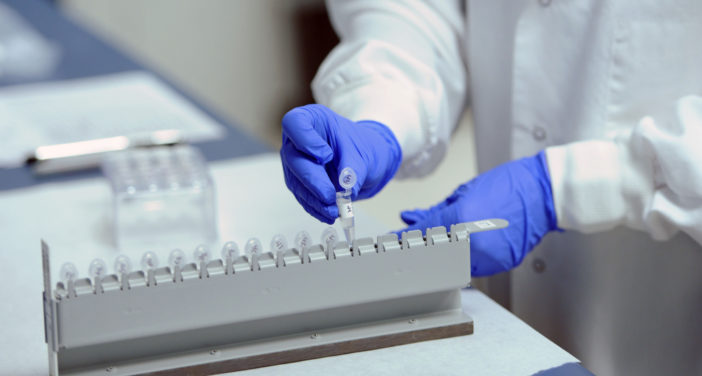Crime scene tape marks an area outside the OC Crime Lab in Santa Ana, where the forensics team is pulling equipment from a van: fingerprint dust, swabs for collecting biological material, cameras, and more.
Inside the building, forensic scientists collect drug and alcohol data from blood samples, swab and test items for DNA left behind, and examine bullets found at a crime scene.

OC Crime Lab Lead Forensic Specialist Brett Doretti demonstrates methods of evidence collection at crime scenes.
Photo by Stephen Carr/Behind the Badge
It’s all in a day’s work for OC Crime Lab employees, who handle more than 30,000 cases per year, and it was all on display during a recent National Forensic Science Week media event.
The lab examines and provides scientific analysis on evidence from crime scenes, as well as blood tests from people arrested for suspected driving under the influence of drugs or alcohol.

OC Crime Lab Director Bruce Houlihan during a tour of the OC Crime Lab in honor of National Forensic Science Week.
Photo by Stephen Carr/Behind the Badge
The OC Crime Lab has been a factor in numerous cases ranging from a recent find of pet hair on a blanket that was wrapped around a body (which matched dogs at a suspect’s home) to a single fingerprint discovered in the 1970s by piecing together bits of a smashed vodka bottle found near a man who had been murdered by serial killer Randy Kraft, OC Crime Lab Director Bruce Houlihan said.
“We never know what we’re going to encounter out at a scene,” said Lead Forensic Specialist Brett Doretti. “It could be anything.”

Foot and tire print collection on display as OC Crime Lab Lead Forensic Specialist Brett Doretti demonstrates methods of evidence collection at crime scenes.
Photo by Stephen Carr/Behind the Badge
That’s why the OC Crime Lab vans are stuffed with equipment such as cameras, small durable lights, portable ladders, sand sifting trays, casting materials for shoe prints or tire tracks, metal detectors to find bullets, and more, Doretti said.
“We’re working at crime scenes that have the potential of catching bad guys that have done things wrong and also the potential of getting all this evidence that is sensitive,” Doretti said. “We’ve had people that have actually bitten fruit at the scene and left their DNA on fruit we can swab and we bring all that back in the lab.”

OC Crime Lab alcohol supervisor Mathew Nixt demonstrates how samples are tested in the lab’s gas chromatograph.
Photo by Stephen Carr/Behind the Badge
Those items are taken to two CSI evidence exam areas, where scientists swab and extract DNA.
“A majority of our samples are touch cases,” said Heather Pevney, assistant director of DNA. “So, anything you might touch, items left behind at a crime scene, a hat, clothing.”
The lab commonly receives swabs from property crime scenes, like a jewelry box that a thief rifled through or a computer cord that was unplugged before a computer was taken, Pevney said.

OC Crime Lab’s gas chromatograph tests blood samples for alcohol.
Photo by Stephen Carr/Behind the Badge
If the forensic specialists found bullets at the scene, however, that goes to a different department.
Ballistics experts at the OC Crime Lab use 3D technology to maintain a database that matches bullets and cartridges to weapons used in a crime.
The crime lab has had more than 400 hits since adopting the OCBULL3T technology four years ago, said Tom Matsudaira, a firearms forensic scientist. Most of them were Orange County cases, he said.

OC Crime Lab forensic scientist and bullet recovery technician Allison Flattum demonstrates water tank ballistics testing inside the forensics firing range.
Photo by Stephen Carr/Behind the Badge
These experts examine “bullets from crime scenes, cartridge cases left behind at crime scenes, and if we get a suspect or perpetrator and they have a gun, we will test-fire that gun… and scientists and analysts will make a comparison,” said Joseph Jaing, assistant director of criminalistics. “We’ll look for identifying marks that would correlate, indicating that it came from or through the barrel of the firearm.”
A water tank in the basement – developed for this purpose – slows bullets without leaving a mark on them so that pristine bullets and cartridges can be scanned and logged for comparison, said Forensic Scientist Allison Flattum. Another section of the basement allows collection of gunpowder patterns and distance, she said.

OC Crime Lab forensic scientist and bullet recovery technician Allison Flattum demonstrates water tank ballistics testing inside the forensics firing range.
Photo by Stephen Carr/Behind the Badge
The OC Crime Lab also processes blood samples – looking for both alcohol and drugs that might be in a person’s bloodstream.
Machines in one room identify blood alcohol levels by heating the blood until the alcohol evaporates, and then catching and analyzing the contents of the evaporation. The gas chromatograph-mass spectrometer then identifies the type of alcohol, differentiating between drinking alcohol, rubbing alcohol, and inhalants such as Dust-Off, glue, and paint thinner, said Matt Hewnixt, senior forensic scientist and forensic alcohol supervisor.

Assistant Director of DNA Heather Pavney during a tour of the OC Crime Lab during National Forensic Science Week.
Photo by Stephen Carr/Behind the Badge
Surprisingly, Dust-Off is a common result, Hewnixt said.
In an adjoining room, forensic scientists are celebrating a new addition: “David.”
David, a liquid chromatograph quadrupole time-of-flight machine, helps the lab identify substances in the blood of impaired drivers, overdose victims, drug-assisted sexual assault victims, and others, said Ariana Adeva, supervising forensic scientist of toxicology.

OC Crime Lab Senior Forensic Scientist Dani Mata demonstrates how samples are tested in the lab’s new liquid chromatograph that can test 110 samples at once and detect 300 drugs at one time, in approximately 18 hours.
Photo by Stephen Carr/Behind the Badge
“We’re able to screen for approximately 300 drugs and compounds,” said Ariana Adeva, supervising forensic scientist of toxicology. That’s up from 50 drugs previously and includes prescription and synthetic drugs, Adeva said.
It’s no easy task – it takes David 18 hours to examine 110 blood samples. Next, forensic scientists verify the results using similar machines dubbed Alvin, Simon, and Theodore.

OC Crime Lab Senior Forensic Scientist Dani Mata demonstrates how samples are tested in the lab’s new liquid chromatograph that can test 110 samples at once and detect 300 drugs at one time, in approximately 18 hours.
Photo by Stephen Carr/Behind the Badge
“We’re hoping that in the coming years this is going to help us to detect a lot of the synthetics that are coming onto the scene,” Adeva said.

Historic photos of involving the OC Crime Lab on display in the lab’s hallways.
Photo by Stephen Carr/Behind the Badge

OC Crime Lab alcohol supervisor Mathew Nixt demonstrates how samples are tested in the lab’s gas chromatograph.
Photo by Stephen Carr/Behind the Badge

The OC Crime Lab’s gas chromatograph tests blood samples for alcohol.
Photo by Stephen Carr/Behind the Badge

OC Crime Lab Lead Forensic Specialist Brett Doretti demonstrates methods of evidence collection at crime scenes during National Forensic Science Week.
Photo by Stephen Carr/Behind the Badge

Black powder used for fingerprint collection is on display as OC Crime Lab Lead Forensic Specialist Brett Doretti demonstrates methods of evidence collection at crime scenes.
Photo by Stephen Carr/Behind the Badge

OC Crime Lab Forensic Scientist Jennifer Jarrett prepares samples to be tested in the DNA lab.
Photo by Stephen Carr/Behind the Badge

Tom Matsudaira, an OC Crime Lab forensic scientist in firearms, demonstrates how they use scanning technology to add, analyze, and compare patterns in an imaging database to effectively analyze bullets and cartridge cases.
Photo by Stephen Carr/Behind the Badge

OC Crime Lab forensic scientist and bullet recovery technician Allison Flattum demonstrates water tank ballistics testing inside the forensics firing range.
Photo by Stephen Carr/Behind the Badge

OC Crime Lab Forensic Scientist Jennifer Jarrett prepares samples to be tested in the DNA lab.
Photo by Stephen Carr/Behind the Badge

Tom Matsudaira, an OC Crime Lab forensic scientist in firearms, demonstrates how they use scanning technology to add, analyze, and compare patterns in an imaging database to effectively analyze bullets and cartridge cases.
Photo by Stephen Carr/Behind the Badge
 Behind the Badge
Behind the Badge





